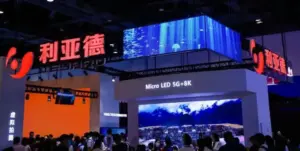Beijing’s Leyard Optoelectronics is looking at $100 million in MicroLED sales this year as it touts a potential 80% drop in costs of manufacturing. That’s if all goes according to the plan. The company is looking a number of options to reduce its MicroLED costs and leveraging its relationship with Saphlux on the NPQD R1 MicroLED chip. For the first nine months of this year, Leyard says it has sold nearly 500 million yuan in MicroLED products, and has not yet booked a further 280 million year to close out the year, mostly for large screen cinematic displays.
| Leyard (millions of yuan) | Q3’23 | $M | Q2’23 | $M | Q1’23 | $M |
| Revenue | 2,005.09 | $280.71 | 2,235.63 | $312.99 | 1,782.13 | $249.50 |
| Total Cost of Revenue | 1,379.33 | $193.11 | 1,619.99 | $226.80 | 1,252.21 | $175.31 |
| Gross Profit | 625.76 | $87.61 | 615.64 | $86.19 | 529.92 | $74.19 |
| Selling/General/Admin Expenses | 357.12 | $50.00 | 332.08 | $46.49 | 326.51 | $45.71 |
| R&D Expenses | 118.08 | $16.53 | 97.41 | $13.64 | 86.17 | $12.06 |
| Interest Expense | 23.88 | $3.34 | -29.02 | -$4.06 | -19.6 | -$2.74 |
| Other Operating Expenses | -19.56 | -$2.74 | -34.09 | -$4.77 | 6.52 | $0.91 |
| Total Operating Expenses | 1,858.64 | $260.21 | 1,987.89 | $278.30 | 1,651.93 | $231.27 |
| Operating Income | 146.45 | $20.50 | 247.74 | $34.68 | 130.2 | $18.23 |
| Other Expenses | -0.59 | -$0.08 | -1.61 | -$0.23 | 0.51 | $0.07 |
| Income Before Taxes | 145.86 | $20.42 | 246.13 | $34.46 | 130.72 | $18.30 |
| Income Tax Expense | 23.94 | $3.35 | 26.94 | $3.77 | 18.52 | $2.59 |
| Net Income | 121.92 | $17.07 | 219.19 | $30.69 | 112.2 | $15.71 |
In general, Leyard seems to be profiting well from its growth in Asia, Africa, and Latin America with a near 50% increase in sales of smart displays. It’s overseas business represents about 30% of the company’s sales today, but the company is looking to grow it to be 50%. But, it has been touting its MicoLED expertise for a number of years, and is hoping to show that, as a Chinese display vendor, it has tecnology to keep the country’s display industry on the development curve with the rest of the world.
Opting for MIP
Leyard has also said that it will to MIP (Micro LED in Package) packaging to reduce costs in its MicroLED production. MIP involves packaging MicroLED chips at the chip-level during early manufacturing stages, before MCOB (module chip-on-board) packaging. The MicroLED chips are transferred to a substrate using mass transfer technology. After the initial MIP packaging, the panel is cut into individual small chips which undergo chip splitting and light mixing. This is followed by SMD (surface mount device) processing and screen surface lamination to complete the display.
MIP packaging offers several advantages. It enables full RGB MicroLED pixel measurements, sorting and mixing to achieve extremely high brightness, high contrast and consistent display effects from any angle. MIP allows for calibration and consistent ink color in MCOB modules by ensuring uniformity of packaged chips. The high adaptability of MIP packaging permits mass production and wafer manufacturing, decreasing chip costs. By eliminating defective screening before shipment, MIP improves yield rates and reduces rework costs. Also, there may be compatibility with existing equipment that reduces R&D and equipment investments.

